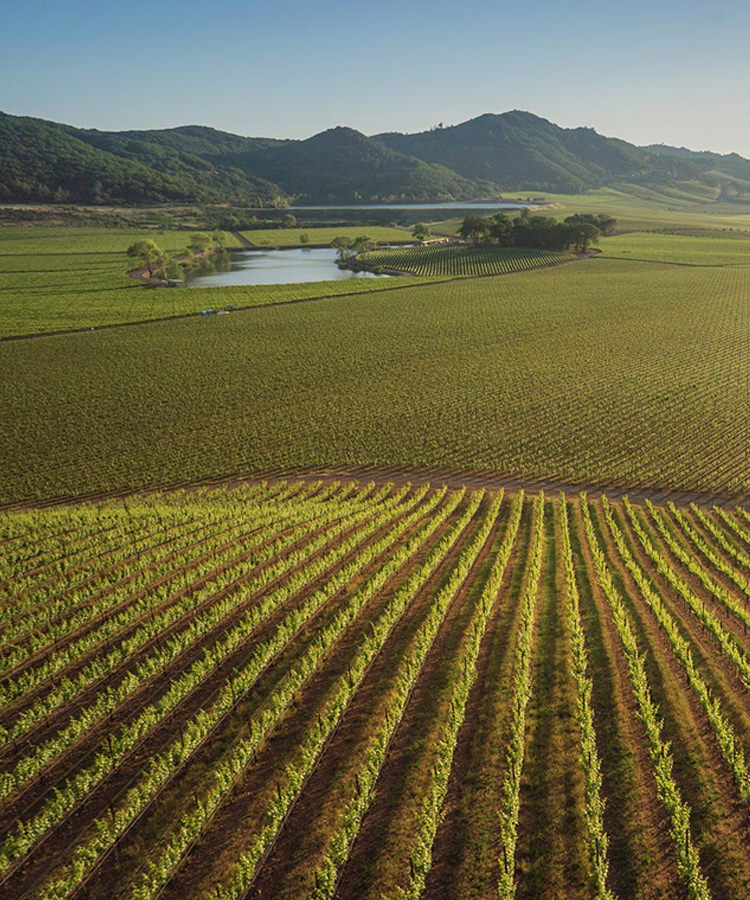Sangiovese, that thin-skinned and temperamental Italian grape, has many boosters. Tuscans will tell you that the varietal can only grow in their region’s rocky, clay-based galestro soil. There, the fine balance of constant sunlight with moderate temperatures permits Sangiovese to ripen evenly.
“Sangiovese is like an Italian man,” says Beppe D’Andrea, the affable senior brand ambassador for Ruffino. “He is late to rise, or ripen, but once he does he works very hard. And most importantly, he can’t stray too far from his mama. Mamma Italia.” Ruffino has been making Chianti since 1877, and D’Andrea has been picking grapes and making wine throughout Ruffino’s six Tuscan estates for more than 30 years.
On the one hand, D’Andrea has a point. Sangiovese is a sensitive muse.
Even within Tuscany, Sangiovese tastes dramatically different depending on the clone, vineyard site, and microclimate. This explains why there are so many sub-classifications, from Brunello di Montalcino to Vino Nobile di Montelpulciano to Chianti Classico Riserva.
Meanwhile, California may not be Sangiovese’s birthplace, but the Italian varietal has a long history in the state, dating to early waves of Italian immigration to the United States. Fourth-generation winemaker Ted Seghesio says that when his great-grandfather emigrated to Sonoma County in 1886 to work as a winemaker at the now-defunct Italian Swiss Colony, Sangiovese had already been planted in adjacent vineyards.
Then, in the 1980s, the Italian varietal became trendy. The Cal-Ital movement found many vintners struggling to reproduce the success of Cabernet Sauvignon by eagerly planting Italian grapes throughout the Napa Valley. Many winemakers jumped on the bandwagon by growing Sangiovese.
Unfortunately, a significant number of vines were planted on rich, fertile soils using inferior clonal material. This led to excessive clusters per vine, resulting in highly acidic, poorly colored wines that lacked personality. Production nonetheless continued ramping up through the 1990s, topping out at 579 acres of Sangiovese planted in 2001.
Eventually, the bubble burst. Big wineries like Robert Mondavi simply gave up. Sangiovese requires prime mountainside soil to produce great wine. In the Napa Valley, the best real estate is still reserved for Cabernet Sauvignon. This makes sense when you consider that Cabernet Sauvignon is worth twice as much: In 2016, Cabernet averaged $6,830 per ton versus Sangiovese’s $3,463. However, it also made for for less-than-ideal conditions for sensitive Sangiovese.
According to the Napa County agricultural crop report, last year Sangiovese occupied merely 141 acres planted in the region. That’s less than half of one percent of the valley’s red-wine-grape acreage. Only 34 Napa Valley wineries are currently producing Sangiovese in small volumes.
Glenn Salva, estate manager of Antica Napa Valley, one of the few remaining Sangiovese growers, believes a number of factors make the varietal challenging in northern California. “While we don’t have scientific data to support this, we feel the bright white sunlight that we have in Napa Valley is very different than the hazy sunlight in Tuscany,” Salva says. “The California sunlight allows the grapes to ripen in completely different ways. The intense bright white light in Napa Valley allows our grapes to ripen with higher sweetness and lower acidity.”
This sweetness translates to higher alcohols, a contrast with Tuscan Sangiovese, which typically has lower levels of alcohol but maintains brighter acidity. “Personally, our Napa Valley Sangiovese leans to more purple fruit such as plum while the Tuscan Sangiovese leans to more red fruit such as dark sweet cherry,” Salva explains.
Antica Napa Valley is the sole vineyard outside Italy operated by the Antinori family. The Antinoris have been making Chianti at a dozen Tuscan estates for more than six centuries, or 26 generations. Their Napa operation produces predominantly Cabernet Sauvignon (50 percent) and Chardonnay (25 percent). The few acres dedicated to a Sangiovese Grosso clone — the same one used for Brunello di Montalcino — lie on a steep mountainside parcel with rocky, volcanic soil.
Antinori’s president, Albiera Antinori, acknowledges this discrepancy. “Sangiovese’s best place is here [in Tuscany],” she tells me when I visit her Tignanello estate. “Even at Antica, it is nice but it does not have the same complexity. We took a lot of the vines out. For a number of reasons it never really gave us the satisfaction that the Sangiovese does here. If we were able to produce such a high-class Sangiovese as Cabernet, it would not be a question of money, it would be a questions of pride. But the Sangiovese really is best in Tuscany. That’s it.”
Beyond Napa Valley, winemakers throughout California are also growing and making Sangiovese. Amador County’s Vino Noceto, Lodi’s Sorelle and Macchia and Sonoma’s Seghesio all bottle the grape.
“Ours contains more varietal fruit characteristics – blackberry and cherry,” says Seghesio. “And seemingly, [Napa Sangiovese] cannot age as long,” he adds. “Tuscan Sangioveses are truly sublime and often contain site-specific qualities that are unique to Tuscany – layered notes of earth, spice, nuance and length in the finish.”
Success, like Sangiovese, has many authors. Those who prefer the sweeter, plummy flavors of Napa Sangiovese are hardly wrong for seeking out available California iterations.
Eventually, though, Seghesio thinks the playing field will level.“Perhaps, after we have been growing Sangiovese in Sonoma for 23 generations or 600 plus years, ours, too, will measure up.”
